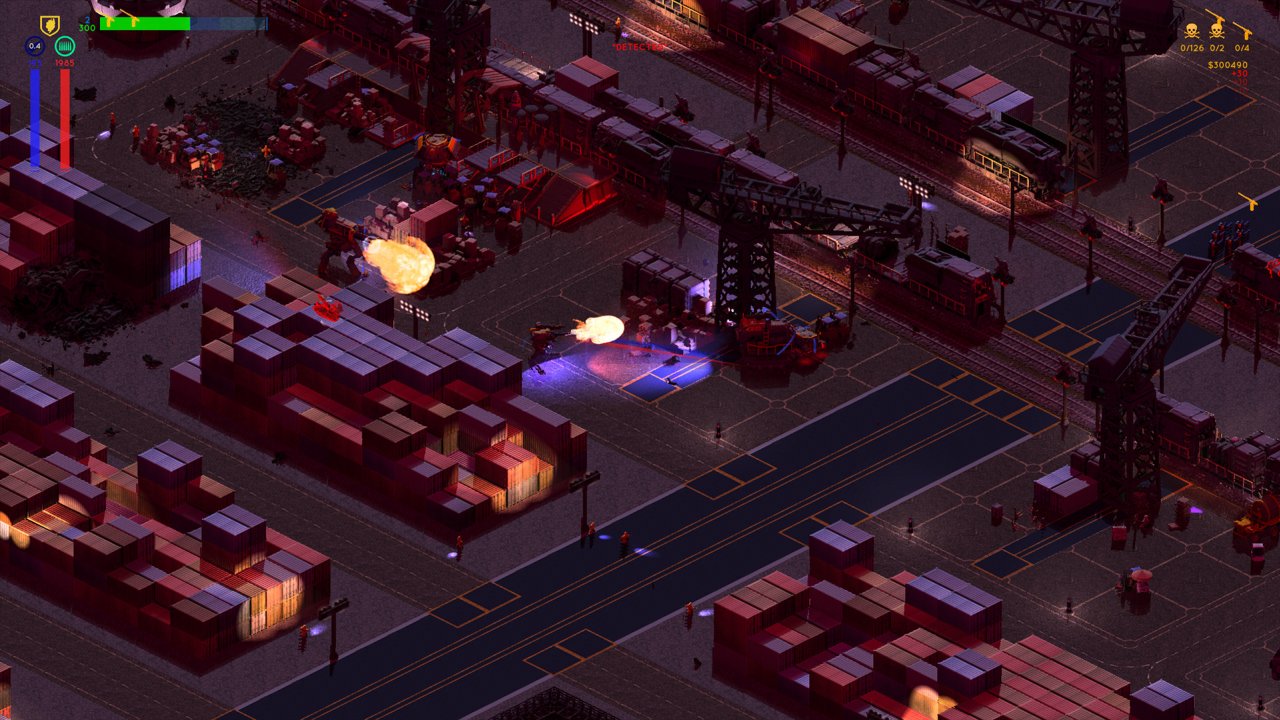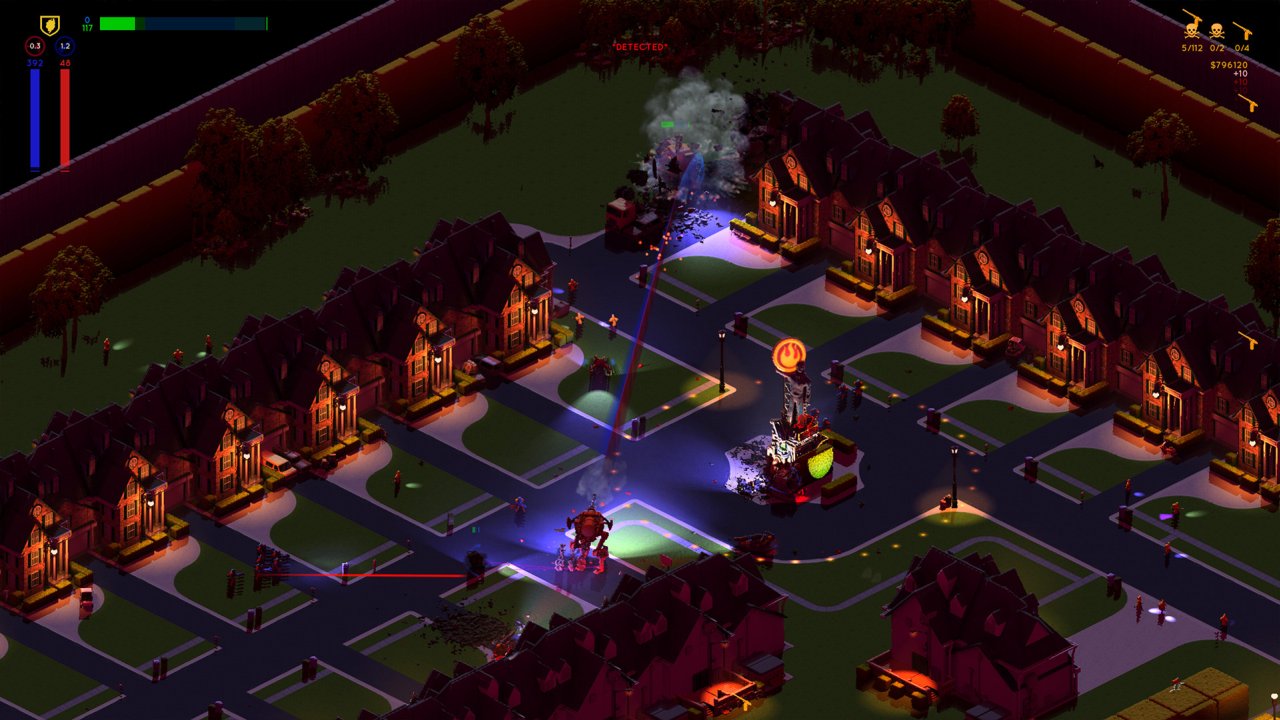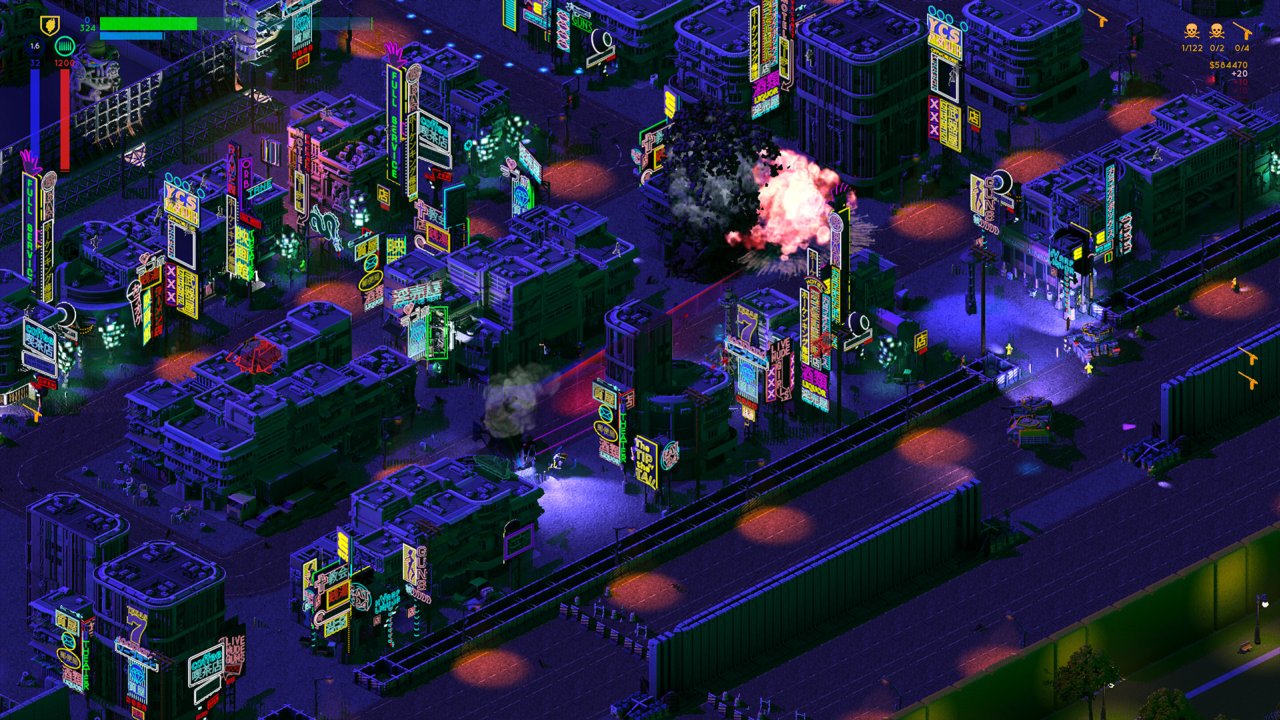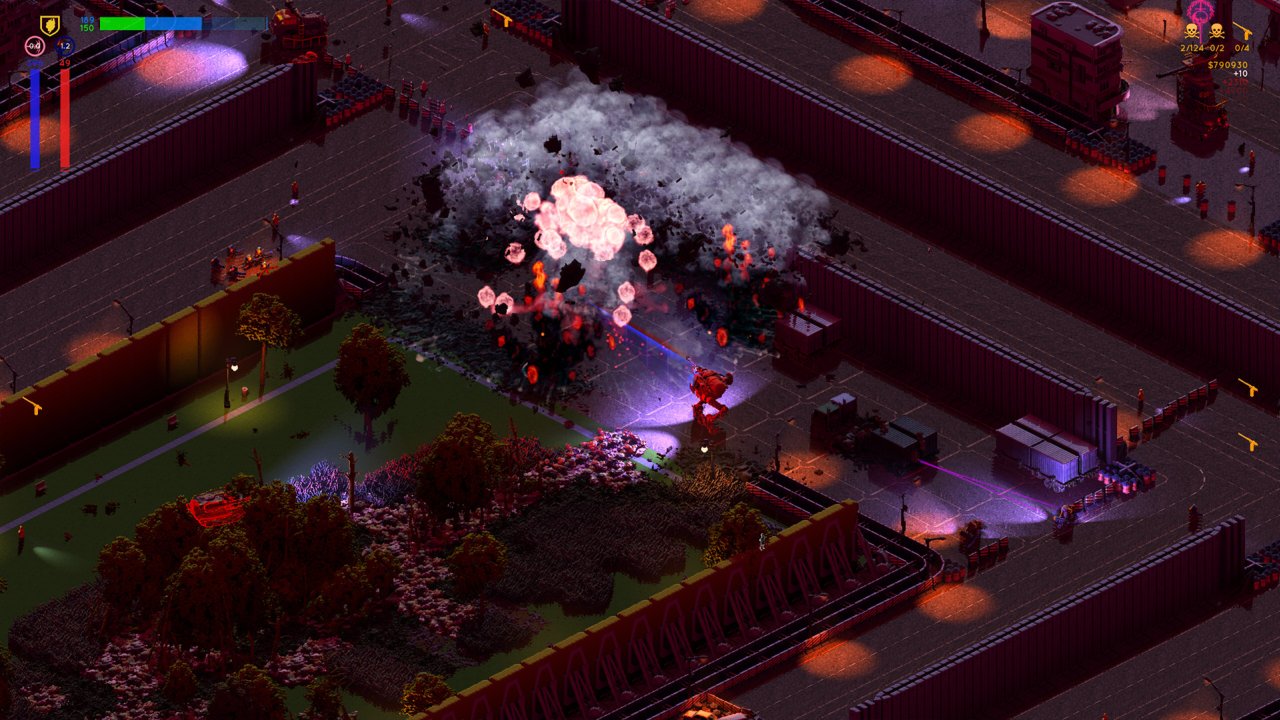Brigador Review
Chaotic mecha missions with excessive demolition
Almost every video game enthusiast, no matter how cluttered their Steam library or how many overloaded shelves line their living room, can remember a time when they were small and reliant on pocket money enough to make do with whatever games they had, regardless of value or quality. For me, a snotty child with zero ambitions towards urban planning, that was SimCity 3000. Did I understand how to set taxes or plan zones? Did I recognize the need for proper power distribution or a place to dump the mountains of waste created by my filthy, ungrateful citizens? Good lord, no, but that didn’t stop me building choking, degenerate metropolises with silly names and confusing road networks. Then, when the money began to run out and people grew weary of their unfulfilling lives in WillyVille, I took the path of all responsible leaders: I opened the disaster menu, chose a destructive event, and watched as the whole city was slowly reduced to one giant isometric heap of rubble. With time, and the introduction of a burned CD of Need for Speed III, I gave up my mayoral responsibilities, but I never quite lost my fondness for the cathartic experience of destroying a city that somebody clearly went to considerable effort to make. With Brigador, an isometric strategic shooter about smashing buildings and—when the situation demands it—enemy mechs, I may finally have found the hands-on city-destroying disaster simulator that my younger self often wished for.

The best way I can describe Brigador is that it’s what would happen if a lone unit from an obscure RTS went rogue on its frothy-mouthed creator one day and embarked on a series of suicidal one-man guerrilla warfare missions. You’re given a heavy-duty war machine with enough armament to level a football stadium, dumped into a neatly-tiling isometric depiction of some cyberpunk hellhole under the neon-lined gauntlet of an occupying militaristic force—the state, or perhaps just a troublesome faction—and then you unleash hell to the beat of the pulsing synthwave by driving around shooting at things until either you die or your objectives are ticked off. The isometric presentation isn’t just to save on painting the back faces of all the buildings, either; if you go in blasting senselessly and brandishing your turret like a drunk uncle at the annual family get-together, then the cleaner bots will be sweeping your smoking wreckage into the gutter before you can say “put that thing away, for heaven’s sake.” Strategy is a crucial element here; the strategy of hit-and-run strikes, smokescreens, cloaks, hasty relocations and devastating ambushes. It’s a mech simulator with the simulator sucked out, and the resultant void filled with hectic fast-paced isometric violence.
Sadly, that little ‘rogue RTS unit’ description isn’t quite the canonical explanation for all these shootybangs. The official story, as given by the opening campaign mission—followed by some assorted text screens, when that isn’t quite enough—is that there’s a big space colony out there that’s been taken over by a sinister dictatorial foreign regime, and while this would usually attract intervention from some outside power, they’ve all been carefully avoiding the colony’s hopeful glances on account of the fact that the planet is bristling with enough anti-orbital artillery guns to turn the moon into a fine, bronchitis-inducing dust. You are a mercenary who has signed up to assist with the organized rebellion—possibly because you went and trod on a fleeing member of the upper crust with your big stompy mech on your way into the city—and that’s more or less all the framing you need for a series of missions about shooting everything that moves and razing the rest to the ground.
Well, more accurately, a pair of series of missions. There’s one mode labelled ‘campaign’ and another labelled ‘freelance’, but frankly it feels more like they came up with two different ways of implementing a campaign simultaneously and didn’t want to leave either of them out. The first campaign—that is, the campaign campaign—is a set of missions with fixed layouts and a choice of four predefined loadouts, while the not-actually-a-campaign campaign is a set of completely different, more loosely-ordered missions with recurring districts, the ability to edit your loadout, and a store screen for buying new vehicles, pilots, weapons and tools. None of this is a bad thing, per se—it’s not as if Brigador has to worry about collapsing under the weight of Ubisoft-style bloat any time soon—but it is an odd state of affairs, especially considering that the money earned in the campaign can be spent in the freelance store. If you spend the vast majority of your time in the campaign missions before dipping your toes in freelance, as I did, then you can more or less run amok in the shop like a sheltered urbanite preparing for a camping trip, which makes one question the stability of the progression system a little bit. Oh well.

You will want to run amok in the shop at some point, though, because if there’s one thing Brigador does well, it’s having a preposterous number of customization combinations and making them all at least enjoyable enough to try once or twice. It’s a very broad sort of formula; not a lot of depth in the fundamental systems, but enough variety to keep things engaging from mission to mission. Vehicles range from colossal stompy mechs that can topple an apartment block with a single thrust of their mighty boot all the way down to titchy power suits that scuttle from side-street to side-street, together with a healthy smattering of tanks, buses, treadbikes, hover-vehicles, bulldozers, and one particularly preposterous war machine that looks like the result of somebody playing Jenga with cars down at the scrapyard. Each vehicle has two weapon mounts that determine what classes of murderous tools you can clip to it, and a defensive gadget of some kind to get out of tight spots.
What’s remarkable, though, isn’t so much the number of combinations themselves—which is, after all, just a matter of throwing a lot of content in a bucket and giving it a good stir—as the fact that the combat supports just about all of them enough to make them viable. Championing freedom of approach is one of those cute things that a lot of games will do to let you feel like you’re actually contributing something to the experience—rather than just being spoonfed the designer’s vision like a loathsome lard-blob of a consumer—but in practice it usually means that either there’s a very clear ‘correct’ approach, or the entire thing is so loosely structured that it violates at least three civil engineering codes. Brigador is neither. You can tear up the streets on a high-speed murdercycle and it feels just as fundamentally right as lobbing cluster bombs from atop a towering siege engine, or sniping five bots at once with a laser cannon across a crowded parking lot, or doing your best Kool-Aid Man impression and crushing a very surprised battle-rickshaw ‘neath your mighty treads.
Ah yes, about that. Destructible terrain is one of those features that’s been thrown in as a stocking stuffer for so many games that its presence has become about as remarkable as the EULA booklet on the inside of the case, but Brigador shows just how dynamic it can feel when you give it top billing as part of a meaningful design. Everything is destructible, given enough persistence and liberal application of the 'put the boot in' button, and everybody is equipped with the means to destroy, so the battlefield is constantly changing in ways that genuinely affect the course of the fight. Buildings are obstacles just as much as they are cover, and once you venture off the roads, the clutter underfoot is sure to hinder you from opening up the taps. There is, of course, no better way to make a surprise entrance—or an unscheduled retreat—than ploughing through a fortification wall, but turn too many tiles to rubble and you'll be uncomfortably exposed when the drones come swarming in. By nature, the combat demands that you're constantly on the move, and even the smallest skirmishes will probably take out an office building or two, so above all else, Brigador requires you to adapt. You can kit out your war machine with all kinds of ultra-specific strategies in mind from the cushy comfort of the menu screen, but once you're actually on the ground, it's all about coming up with plans on the fly and riding the wave of carnage.

Sadly that's not the only context in which Brigador expects you to adapt. I can guarantee with almost perfect certainty that your first few missions will be rife with enough unintentional demolitions and navigational mishaps to rival a sexually-frustrated bonobo at the helm of a bucket excavator, and until you get accustomed to the controls, it’ll be a running theme too. I’m sure tank controls sound like an intuitive method for driving a tank—or even for the mechs, which perform similarly—but in the heat of the moment it’s easy to lose track of your orientation since the absolute last place you’re likely to be looking on the screen is at yourself. Perilous, especially when you suddenly need to three-point-turn your way out of a mortar bombardment. It’s clear that Brigador recognizes this as a problem, since it uses both your headlights and a small HUD arrow to make your current bearing more obvious, but it’s still not much help when you’re trying to blast half a dozen battle-buses to oblivion on the far side of the screen. Your direction’s much more obvious when you’re in the pilot’s seat of an antigravity-class vehicle—they always point towards the cursor; you know, the thing you’re actually focusing on—but learning how to strafe relative to a constantly moving point on the screen is a bit tougher than it sounds, especially when you’ve just spent the last few missions getting accustomed to not parking your tank in somebody’s front living room.
Aiming is another somewhat unexpected barrier to entry, though not without some justification. Each weapon has a unique arc and range, both of which can potentially scale relative to your motion, so there’s often more to hitting a target than just pointing and clicking. It’s a spicy sprinkling of extra strategic depth on top of the existing combat, and for that I gladly welcome it with open arms, but its implementation has resulted in me turning a lot of relatively innocent kindergartens into smoking holes in the ground while the towering siege engines next to them stay relatively untouched. Perspective is the main culprit, followed closely by your targeting display; the isometric presentation doesn’t do you any favours when trying to work out whether a line in space is intersecting with where you want it to, especially not when units can move in any axis and are often higher off the ground than they appear, but it’d be a lot less troublesome to get your head around if the holographic arcs that the game paints to show where your projectiles will land were actually lined up with your cursor, rather than landing a little bit in front or behind as they often do. With enough practice it’s possible to get relatively comfortable with the system, but you’re still liable to end up with egg on your face from time to time when your railgun misses a parked target and vaporizes a row of terraced houses instead.

Perhaps this is—at least in part—the reason why Brigador's difficulty curve looks like a cross-section of my spine after a sleepless fourteen hour flight behind somebody who can’t decide how much they want their seat reclined. Even once you get over the initial hump of learning not to play like a complete plonker, the difficulty of missions—especially in the campaign—often seems completely arbitrary relative to their order, swinging wildly back and forth in the space between nail-ripping suicide runs and joyful massacres on a whim. Some missions will start you close enough to the enemy to choke on their exhaust fumes while others will give you space to work with, and when controlling the number of alerted units on the map is such a key part of ensuring you aren't overwhelmed, the difference is like night and day.
All that aside, Brigador is a rare and unusual game; it follows no discernible trends, it plays off no recognizable nostalgia, and despite it borrowing numerous scraps from simulators, twin-stick shooters and RTSes, there aren’t really any close analogues for it. It’s the kind of game that feels as if it was developed in a total isolation chamber, safe from the currents and eddies of the wider gaming world, and all the better for it. Sure, it’s not going to be the next groundbreaking indie darling any time soon, and it has its fair share of annoyances, but once you’re comfortable with it, it’s the kind of game that you’ll keep coming back to, either for a quick burst of action or to test out an experimental build you dreamed up on your lunch break. Even now I’m wondering what would happen if I kitted out the tiny fragile exosuit with two chain guns and a… hang on a second, can we end this here? I have to go try something.
 Comments
Comments











